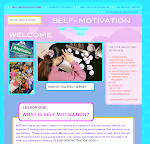Wednesday, January 27, 2010
BP12_2010013_One_Minute_Message-#2
Monday, January 25, 2010
BP9_2010013_Goanimate.-#3

Monday, January 18, 2010
BP5_2010012_VisualThesaurus

The Visual Thesaurus is an interactive dictionary and thesaurus which creates word maps that blossom with meanings and branch to related words. Its innovative display encourages exploration and learning. You'll understand language in a powerful new way.
This is especially beneficial because in a Full Sail online program, the professors are wanting master level writing. This wonderful Web 2.0 gives you a great and visual perspective of word maps and word streams that further the meaning, syntax, semantics and context to your writing in your papers. You know the kind of situation where your looking for the right word and not even a dictionary tool can truly help you. Well the VT is like looking into the connections to that word that make it relevant to you paper or a sentence's meaning. Sometimes you may believe that word is the best choice but this gives you more options than a regular dictionary can ever do. This site would be awesome for SAT Prep or GRE Prep. Now that's an even better version of the dictionary to me.
WEBSITES BREAKDOWN:
Say you have a meaning in mind, like "happy." The VT helps you find related words, from "cheerful" to "euphoric." The best part is the VT works like your brain, not a paper-bound book. You'll want to explore just to see what might happen. You'll discover -- and learn -- naturally and intuitively. You'll find the right word, write more descriptively, free associate -- and gain a more precise understanding of the English language.
- Find the right word. The VT has over 145,000 English words and 115,000 meanings. Find the word you need and discover related meanings.
- Develop a better vocabulary. See how words are used in different parts of speech.
- Use words precisely. The intuitive interface helps you find words through their semantic relationship with other words and meanings.
- Master word usage. Roll over a meaning to see its definition and example sentences that express that meaning.
- Improve your grammar. Meanings are color-coded to indicate parts of speech.
- Explore 39,000 proper nouns. Historical figures, phrases and trademarks are included. Look up Mozart, Manda or simply, "M."
- Check your spelling. The VT suggests a word if you spell it wrong.
- Hear words pronounced correctly. The VT offers both American and British pronunciations (Internet connection necessary)
- Personalize your experience. Use the Settings Panel to control font size, filter content, display up to 17 semantic relationships and more.
- Browse language in 2D or 3D. Rotate word maps in three dimensions to reveal complex relationships.
- Connect to the Internet. Right-click on any word to launch an Internet search for images or information.
BP8_2010012_OneMinuteMesg-#1

The Lumosity website featured online games for building your brain. I found this site interesting while learning about brain training concerning logical- mathematical, verbal-linguistic, spatial-and visual learning styles. More specifically they had games that increase your brains neurotransmission of information such as games for memory strengthening, brain processing, task switching, spatial orientation and quantitative reasoning. It was like an online exercising program for your brain.
Two of the 30+ games that I feature in the video are called Speed Match- a game that can help to fortify memory and Raindrops- a game where you did math computations at a slow rate and it accelerated with more computation to increase fast math computation and quantitative reasoning.
WATCH THE VIDEO
Thursday, January 14, 2010
Monday, January 11, 2010
BP4_2010011_RSS

Though RSS feeds are a simple concept , when you have to create one from your own voice or content it becomes complicated. There are so many different types of RSS- Real Simple Syndication devices. This going back and forth between my desktop and the computer, to my favorite websites and videoblogs has been a little tiring. I made the mistake when I initially saw the Feedly RSS, I loved the "look" of it but found myself not only needing a website to drop the information into in order to create this splash page. Then I noticed something. This site was more connected and formatted to twitter, google reader and firefox. They now have a Safari plugin of sorts. As i felt the stress headache coming on I realized that the whole point of this was for this process to be easy but I kept on trying to understand its ordinances- I wanted my magazine like page. I even tried to place it into an html snippet/ on iweb. Needless to say, I found bloglines set up to be the most efficient and user friendly.
Education Week
This site is great for its blogs on the latest information with schools; they have info on test scores and how to improve literacy, digital education and research on any topic, for instance; No child left Behind and students turning towards the web for homework. Woohoo! Waht does that sound like?
Sunday, January 10, 2010
BP2_2010011_EduUses4Blogs
 FOR EDUCATORS
FOR EDUCATORSBlogs are a very popular type of Web. 2.0 tool. A blog is a communicative device that allows educators to teach their students by a learn by doing, writing and reflecting method which is a part of the R2D2 Model for multi-media assets. This practice is an improvement from the isolated education cycles of the past where students are given the work and have to regurgitate its comprehension not always through collaborative efforts and peer to peer reflection. Blogs change how information is formulated and then shared amongst peers and scholars alike. Observations in problem-based assessments have governed industries outside of education, namely engineering, medical and scientific. Blogs can be introduced into middle school aged students. While they are building a repertoire of online interaction, they will likely assimulate into further developments that involve education. Teachers can continue to use blogs to promote topics relevant to classwork, enhanced comprehension and teachers feel they promote literacy in the classroom (Hufaker, 2004)* By teachers exercising these simple task involved with blogging, students will develop professionalism in there writings knowing that there comments may hang on the world wide web for another millennium.
BP3_2010011_Lumosity

Another interesting web 2.0 device for cognitive learning processes was explored on http://www.lumosity.com/.
BP3_2010011_LearningGamesForKids
 At first I became a little frustrated at all the tools that are available online; and not all of them are educationally efficient tools.
At first I became a little frustrated at all the tools that are available online; and not all of them are educationally efficient tools.






